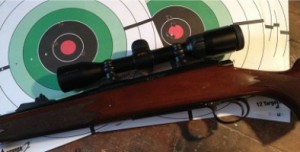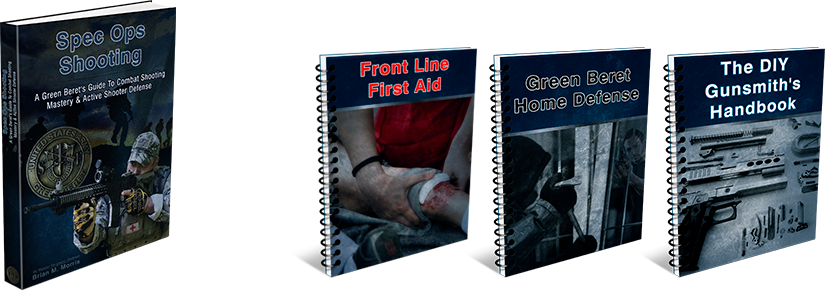I got a text from a co-worker this past weekend. Deer season is nigh here in Maine, and he was out doing the pre-season rifle check-up. “My 7 Mag is all over the place. I can’t shoot.” is what he sent to me. I found this hard to believe; the man is a very experienced bow shooter; he turned down an offer to shoot competitively for a major bow manufacturer. I asked him his setup.
It was a Ruger Model 77 Mark II in 7mm Remington Magnum, a Simmons fixed 4x scope, and cheap bargain-bin pawn shop reloaded ammo. I think most experienced shooters could spot a couple quick problems with that brief description, but it also brings up a valid point: if a modern, high quality gun isn’t shooting reasonably well for you, (“reasonably well” varies greatly from gun to gun and shooter to shooter, but a scoped center fire bolt-action rifle of a well-known manufacturer should reasonably be able to shoot 2-3” groups at 100 yards, benched, even with an inexperienced shooter), then there’s a pretty good chance that there’s more going on here than “I can’t shoot.”
By Drew (Road Warrior), a contributing author of SHTFBlog & Survival Cache
Starting From the Ground Up
All the methods to getting your gun to shoot right that I’m going to write briefly about are ones that 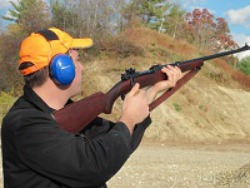 can be done at home with a good screwdriver set, a plastic-ended mallet, a cleaning kit with a good solvent and oil, and a good, high-quality gun grease. If the balloon goes up, you’re going to need to do work on your guns yourself…and being able to make sure your rifle is doing its best for you without bringing it to an experienced gunsmith will be a valuable skill.
can be done at home with a good screwdriver set, a plastic-ended mallet, a cleaning kit with a good solvent and oil, and a good, high-quality gun grease. If the balloon goes up, you’re going to need to do work on your guns yourself…and being able to make sure your rifle is doing its best for you without bringing it to an experienced gunsmith will be a valuable skill.
To start with, we need to make sure the rifle is fundamentally sound and solid. The very first thing to check when a rifle is “shooting loose” is that everything is tight. Using a good, high-quality screwdriver set (preferably utilizing a properly-fitting hollow-ground bit) tighten all the screws. On a relatively modern bolt-action, start with the stock-to-action screws.
These should all the nice and tight – but not so tight that you’re white-knuckling the screwdriver to get a better grip. There are usually two to four of these screws , all with the heads on the underside of the gun. Look behind the trigger guard, in front of the trigger guard, on the very forward part of the magazine floorplate, and in some cases (like my buddy’s Ruger 77) there is a screw underneath the magazine floorplate: you must pop open the magazine bottom to access it.
On some rifles, like pre-’64 Winchester Model 70s and Remington 721/722/725s, as well as Ruger No. 1s, there is a screw that goes into a lug on the barrel, pulling the barrel down tightly into the stock. Snug this screw up as well…if you find that your gun isn’t shooting really well after all the following steps, try backing this barrel screw off a bit to change the barrel harmonics and pressure – sometimes it’s just crazy enough to work.
If you use a different type of rifle, say a typical lever-action Winchester or Marlin, make sure the screws that run through the tang (the upper and lower metal receiver extensions where you grip the rifle with your firing hand) are tight, as well as the rest of the action screws. Lever actions, especially with heavier-recoiling hand loads, can have the screws work loose, as they actually have moving parts bearing on these screws.
With pump-action guns and sporting-type semi autos, make sure pins are driven in flush with the non-marring mallet, and any action screws are snug. All this will ensure that things are where they need to be, and not in danger of jarring loose.
In AR-15 type rifles, there’s not much you can do bit make sure the pins are sitting flush. I like to place Ultimate Arms buffers in the lower receiver; it seriously tightens up the alignment between upper and lower receivers on an AR system. If you don’t have the tools and know-how, bring your AR to a gunsmith and make sure the headspacing and barrel nut torque are all within spec.
Optics
Next, let’s take a look at your scope mounting system (if you’re running a scope.) These are far and 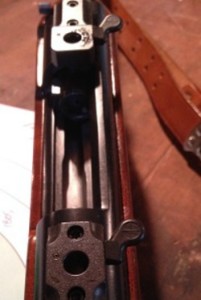 away the biggest culprits of a gun not shooting well. Pull the scope rings and scope off of the bases and check the mounting screws in the bases for tightness. These actually wouldn’t be terribly off with a single drop of blue Loc-Tite on each of the thread shanks before being re-mounted and tightened again.
away the biggest culprits of a gun not shooting well. Pull the scope rings and scope off of the bases and check the mounting screws in the bases for tightness. These actually wouldn’t be terribly off with a single drop of blue Loc-Tite on each of the thread shanks before being re-mounted and tightened again.
I know a lot of knowledgeable writers say tighten them as brutally tight as you can with no Loc-tite, but unless your gun is in a vice and you have a perfectly-fitting screwdriver, you’re just begging for a stripped screw head. Throw a drop of Loc-Tite on and get it as tight as you can without buggering the screw head. The scope base screws are the most crucial element of your shooting system: if they are not a solid, continuous piece with the action, your rifle will not shoot well. This is why you see lots of rifles coming with integral dovetails and picatinny rails: one less thing to go wrong. If your base is incorporated into the gun, you’ve got one less contingency to worry about.
Unscrew the screws that hold the scope in the rings, separating the rings into halves. If you have the type of rings that split into upper and lower halves (like the standard Weaver-type setup), keep the lower halves mounted to the bases, and make sure the mounting screws are VERY snug. I never Loc-tite the ring-to-mount screws; I like my scopes to be removable in the field if they decide to stop working for whatever reason they may choose.
Place the scope back into the lower rings (that are mounted to the rifle) and by gently rocking the scope in the lower halves of the rings, make sure that the scope sits in the rings squarely and evenly. You want to avoid one ring being even minutely higher than the other, or canted: this will warp the scope body as the rings are tightened back down. No Bueno. If the scope sits in the rings well, you’re good to go. However, if it does not, you probably should look into a new set of rings. Don’t go bargain-bin on your rings – buy some good ones. Warne, Weaver, LaRue, Talley, Leupold, Redfield, Burris, and many others make good mounting setups to look into.
When re-mounting your scope, get some rubbing alcohol on a cotton ball, and thoroughly degrease the scope body and the inside of the rings. You don’t want ANY grease inside here; it will promote scope slippage under recoil. Place the scope in the rings, and tighten the screws in them gradually until the scope stays in place, but can be moved by gently pulling or pushing on it.
To simply get your optic set for proper eye relieve (skip this step for red dots and other zero-eye-relief optics), stand up, close your eyes, and bring the rifle naturally to your shoulder. When you open your eyes, you should be seeing 100% of the scope’s field of view clearly – no black whatsoever.
The desired end result will be that under quick action, when you bring the rifle to your shoulder, you won’t be moving your head neck back and forth to try to get the full view – it will be good go to the second it comes up. Most scopes are in the 3-4” range for eye relief, so don’t start with the damn thing right up against your eye. Slide the scope back and forth gently, bringing the rifle up again and again with closed eyes, until you get the best eye relief and full view through the scope.
Take your time – this is one part of the rifle setup that will always pay off to do it right. Be careful not to yank the scope around too harshly; it can drag on the scope rings and scratch. If it’s dragging, loosen the ring screws up just a touch.
Once the eye relief is good, square the crosshairs up to your eye. You can bring it to a shop and have it leveled properly, but I set it to my eye – everyone holds their gun just a little differently. Finally, adjust your focus if the scope has adjustments.
Using a properly-fitting screwdriver, gradually and EVENLY tighten the ring screws down. You don’t 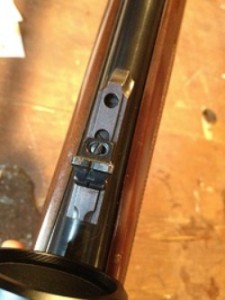 want to tighten just one screw all the way down till your palm bleeds, then go to the next one down the line for a similar treatment; that will put uneven pressure on the scope body and could wreck scope internals or throw off lens alignments. It could also turn the scope in the rings and throw off your cross-hair alignment.
want to tighten just one screw all the way down till your palm bleeds, then go to the next one down the line for a similar treatment; that will put uneven pressure on the scope body and could wreck scope internals or throw off lens alignments. It could also turn the scope in the rings and throw off your cross-hair alignment.
Work your way around the ring screws, snugging them evenly, then tightening firmly. Make sure ALL of them are as consistently tight as possible. Scope ring manufacturers often give inch-pound measurements for tightening…I’ve never broken out the torque wrench but feel free.
A word of caution, though: you will certainly need to re-zero your scope after following these steps. But that’s okay, it’s another excuse to buy ammo and go to the range. If you’re unsure how to sight in your scope, read my article on SHTFblog about how to dial in your scope (Click to read Drew’s How to Zero a Scope). If you’re running iron sights, make sure they are not wobbling around or sliding in dovetails. All iron sights should be solid enough to make you think they were forged on the rifle.
And now, from bottom to top, your optic (should you have one) should be all set. You should be able to grab the scope firmly and try to move it on the mounts, with zero movement. A 100% rock-solid optic setup is what we’re looking for – it will ensure your scope is in the same spot in relation to the rifle all the time. This, along with a rifle that is tight and solid, is the first key to repeatability.
Next To Godliness
Next up, make sure your rifle is clean, especially in the bore. The co-worker of mine hadn’t cleaned 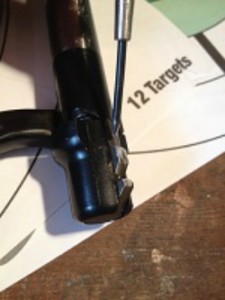 the rifle since he’s owned it! (He said it’s stainless steel so it doesn’t need it.) Burnt gunpowder and carbon, lead deposits, primer compound residue, and copper buildup all do wretched things to accuracy.
the rifle since he’s owned it! (He said it’s stainless steel so it doesn’t need it.) Burnt gunpowder and carbon, lead deposits, primer compound residue, and copper buildup all do wretched things to accuracy.
Add in neglect from moisture or residual salt (if you’re near the ocean) or other corrosive materials and the resulting rust and metal pitting can wreak havoc with your accuracy. If the bore is already pitted or “frosty”, fear not: I have an old 1926-manufactured Winchester .30-06 that has a really dark looking bore (as opposed to smooth, sharp, and shiny) and it will shoot 1” groups all day long with the right ammo…so it might not be the end of the world if your bore is lightly pitted. You gotta get all the rust out, though: that will promote deeper pitting.
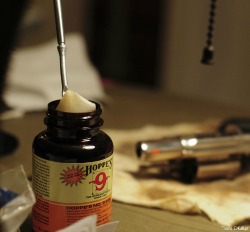 There are a million products out there to clean bores, and all of them say they are the best. I have always used good old Hoppes #9 to clean my bores. It’s easy to find, it works, and it smells good in a weird chemically way. (no really – my old man has a Hoppes #9 air freshener…the ultimate gun guy stocking stuffer.)…as a bonus, you can get it in quart sizes for not much money and it stores REALLY well.
There are a million products out there to clean bores, and all of them say they are the best. I have always used good old Hoppes #9 to clean my bores. It’s easy to find, it works, and it smells good in a weird chemically way. (no really – my old man has a Hoppes #9 air freshener…the ultimate gun guy stocking stuffer.)…as a bonus, you can get it in quart sizes for not much money and it stores REALLY well.
I’ve used 50-year-old cans of Hoppes and it still works great. You’ll also need a good bronze caliber-specific bore brush – I like a stainless steel bore brush to take out encrusted rust. Lots of cleaning patches, a good high-quality cleaning rod (brass or steel – throw those miserable aluminum Wal-Mart cleaning rods out the window. Same with “bore snakes” – they work OK for a pinch, but they’re far from optimal for deep cleaning) with a bore guide if you have to clean from the muzzle end. A good penetrating oil to bust up rust deposits doesn’t hurt either – and you can use it to lightly coat your bore when you’re done to keep it from rusting in the future.
For my old aforementioned Winchester, to clean it for the first time, I took a .30 caliber bullet and 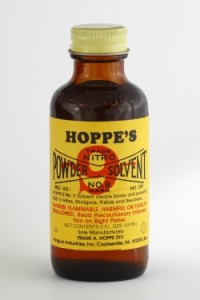 tapped it into the muzzle with a mallet, sealing the bore up pretty well. I then stood it in a corner muzzle-down, and using a narrow funnel, poured Hoppe’s #9 down the bore, and filled it right up. (the wife or others might not like the smell of Hoppe’s as much as you and I do, so I might recommend doing this in the basement or garage. Hoppe’s doesn’t play nice with carpets either, especially light-colored ones.
tapped it into the muzzle with a mallet, sealing the bore up pretty well. I then stood it in a corner muzzle-down, and using a narrow funnel, poured Hoppe’s #9 down the bore, and filled it right up. (the wife or others might not like the smell of Hoppe’s as much as you and I do, so I might recommend doing this in the basement or garage. Hoppe’s doesn’t play nice with carpets either, especially light-colored ones.
Ask me how I know.) I left the Winchester standing in the corner for a couple days, muzzle-down on a rag (it DID leak a tad – be sure to top the bore off regularly). When I brought the rifle outside (recommended!) and pried the bullet out with a pair of channel locks, the Hoppes gooped out of the bore like cold 10W-40, a nasty, blackish-green liquid.
It had eradicated most of the 70+ years of copper and lead deposits the previous owner had graciously left for me, and after a couple hours of scrubbing with a bronze bore brush and about a million patches, the bore cleaned up very well. The effort paid off with great groups at the range, and I’ve taken countless deer with this beloved rifle.
Obviously, this was an extreme example, but it shows that a rigorous cleaning schedule and proper maintenance will A) pay off in the accuracy department; B) keep your firearm ready to go when you need it, and C) save you a shitload of work. So grab your gun cleaning gear, and clean the holy living hell out of your rifle.
If you’re getting green patches out of your bore after using Hoppes or a similar solvent, you have copper buildup. Black patches are carbon, lead. Obviously, you want these patches coming out clean. Follow the directions based on your products, but it’s a pretty easy task to clean your bore. Give ‘er hell!
While you’ve got your maintenance kit out, check out the bearing surfaces (if you can) of any trigger, hammer, disconnector, and/or sear engagements. Some of these parts can be accessed without too much hassle (like on a bolt action rifle or an AR-type rifle), and a bit of light grease on these surfaces can do wonders to minimize friction on these parts, and you may get a slightly better trigger pull. Obviously, if you can’t get to ‘em, you can’t get to ‘em. But I bet your local gunsmith can…he can probably give your gun a decent trigger job in exchange for a couple bucks – ALWAYS money well spent when you’re on the search for accuracy.
Ammunition
This probably goes without saying, but your ammo is a pretty good place for accuracy to go wrong. If 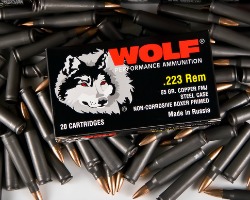 you buy ammo from an unknown maker or in bulk on the cheap, don’t expect much expect to be surprised if it goes “bang” for every round. I NEVER buy bargain-bin “reloaded” or “re-manufactured” ammo. If I’m not personally measuring every powder charge, seating every primer, and selecting bullets, I stay the hell away.
you buy ammo from an unknown maker or in bulk on the cheap, don’t expect much expect to be surprised if it goes “bang” for every round. I NEVER buy bargain-bin “reloaded” or “re-manufactured” ammo. If I’m not personally measuring every powder charge, seating every primer, and selecting bullets, I stay the hell away.
Not only is it a huge unknown quantity, it is 100% without accountability. They are “buy at your own risk”, and thank you, but no thank you. I can’t be firm enough on this: buy your ammo from a well-known, high-quality manufacturer. The US Military doesn’t buy bargain-bin shit when they need their guns to work 100% of the time, so why should you? S
pending an extra 5 bucks per box or 100 bucks per case seems like a cheap deal to me when I know that this ammo will WORK when I need it. I’ve said it before, and I’ll say it again: I never buy boxes of ammo with pictures of animals on it (except for Federal’s “American Eagle” line). Take that as you will (I’m sure SOMEBODY will get mad at that one), but from my experience, it’s pretty much a malfunction in every box. Use it for practice, don’t use it for ammo you have to depend on.
But we’re talking about accuracy here, right? Right. So you buy that box of el cheapo pawn ship ammo. All it says is, for example, “.270 Winchester, 130 grain”. The fella loading that ammo for a quick buck probably didn’t take the time to check that every powder charge is accurate to within 1/10th of a grain.
They probably have different primer makes in the primer pockets. Hell, the bullets might not ever be the same profile or weight. The cases will probably be from different makers and have different case capacities, with consequent different pressures. Worst case, your gun blows up and you have nobody but yourself to blame. Best case, it shoots AMAZINGLY and you have no record of bullet type, powder weight and type, primer type, etc., to get that magic back again.
As ammunition manufacturers are still running full-speed to catch up from the ammo shortage of the past year and a half, when you find ammo, you can usually find good stuff in bulk. Do yourself and your rifle a favor: for ammo that works when you 1,000% NEED IT TO, and you know where the bullet will go 100% of the time, get the name brand stuff. It’s peace of mind in a brass case.
So that really takes care of the rifle and components. Other things you can do to help your rifle along will be: pillar bedding or glass bedding the action (your gunsmith can help you here), getting a good sling and figuring out how to utilize it best to enhance your accuracy. Learn to reload your own ammunition, and tailor your load to your rifle.
And above all, PRACTICE, PRACTICE, PRACTICE. Dry-fire your cleared gun. (centerfires only, not rimfires!). Hit the range with your “oh shit” guns on a regular basis, take training classes that are geared toward what you want to do with the rifle. All of these things, plus the above methods of squaring your rifle away, will ensure that you and your weapons will be ready for when you need them, and let you concentrate on other things that you and your family might need.
by Drew





